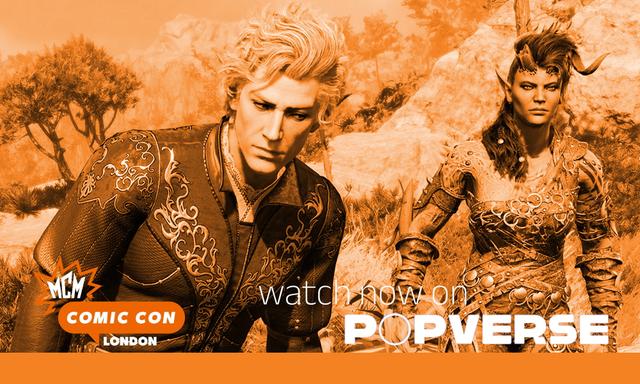If you click on a link and make a purchase we may receive a small commission. Read our editorial policy.
Is Marvel's Spider-Gwen trans? The Spider-Man: Across the Spider-Verse speculation explained
Context and analysis for fan speculation about Spider-Gwen being trans

After years of anticipation, Spider-Man: Across the Spider-Verse has been released in theaters. The sequel to 2018’s Oscar award winning Spider-Man: Into the Spider-Verse has captured the hearts and social media accounts of audiences in theaters everywhere.
With several universes worth of Easter eggs and a cacophony of cliffhangers, the animated sequel offers plenty of conversation fodder. But in the days since Across the Spider-Verse was released, more than a few fans have voiced idea that one of the movie’s lead characters, Gwen Stacy / Spider-Gwen (voiced by Hailee Steinfeld), is either transgender or subtextually coded as trans. Here’s everything you need to know about the Spider-Gwen trans speculation explained – featuring plenty of spoilers from the movie.
Here’s why people are speculating Gwen is trans
The seeds of speculation regarding Gwen being trans were sown in the Across the Spider-Verse trailer. In one shot (also included in the movie’s cold opening), a ‘Protect Trans Kids’ poster can be seen over the doorframe of Gwen’s bedroom. This statement has something of a recurring connection with Marvel on screen, also having appeared on shirts worn by Marvel Cinematic Universe actors Don Cheadle and Tatiana Maslany during promotional media appearances.
After the film was widely released in theaters on Friday, June 2, 2023, elements of Gwen’s narrative and dialogue inspired many fans to take to social media and voice their interpretation of the character as trans. Some of the most shared posts voicing the opinion on Twitter and Reddit have since been deleted or were made by accounts that have since been set to ‘private.’ However, there are some common sources of inspiration cited by many of the individuals who have shared their interpretation of Gwen as trans.
Trans Pride colors

One line of reasoning cited by many who have speculated that Gwen may be trans is the seeming presence of the colors of the trans flag throughout her home universe. The colors of the trans pride flag, which was designed by Monica Helms in 1999, are white, light blue, and light pink. In addition to generally appearing throughout the dimension’s color scheme and on Gwen’s costume, these colors become amplified during a climactic scene in which Gwen ‘comes out’ to her father about her identity as Spider-Woman.
It is worth noting the source material heavily inspires this aesthetic: even the cover of Gwen’s first appearance in Edge of Spider-Verse #2 reflects the impressionistic pastel palette that was used to differentiate Gwen’s universe from the then-respective universes of Peter Parker and Miles Morales. This visual style was continued and amplified in the interior art for Gwen’s subsequent solo series, The Radioactive Spider-Gwen.
Some people online argued that a trans flag appeared on the uniform of Gwen’s father, police Captain George Stacy. However, it seems most likely that this was a different badge that incidentally appeared to be the trans pride colors due to the color filter, which tinges the tint of everything we see in Gwen’s universe.
Why Spider-Gwen’s experience is relatable to trans people

There are many more elements of Gwen’s experience that are relatable to trans people, especially trans people the age of the movie’s teenaged characters. The concept of being forced to live a dual life and hide one’s true self, a relatable experience for adolescent trans people who must hide their true identity from family members, is addressed in the scene in which Gwen comes out as Spider-Woman to her father.
Depending on situation and privilege, for safety reasons, trans people young and old alike may be forced to conceal their true gender – in some situations, even from those closest to them. A reflection of this necessary (but frequently difficult) duality can be seen in almost any of the various Spidey interpretations, not only including Gwen but also Miles Morales and most incarnations of Peter Parker. Both the necessity of hiding one’s truth and the acknowledgement of the emotional labor it takes to accomplish this are intrinsic to the archetypical Spider-Man tale, and both can be unfortunately relatable to trans people who are in the closet, even on a part-time basis.
Another reason that Gwen’s experience is relatable for trans audience members is the fact that her existence has been made illegal. As the movie is released, the advent of draconian anti-trans laws in multiple states across the country prompt the exodus of trans people from places that were once their homes. Gwen’s exile from her original universe into the liminal multiverse serves as a straightforward metaphorical parallel.
The Relatable Spider-Man

However, there is another aspect seemingly common to all Spider-Heroes to which trans fans are sure to relate: the relentless background noise of alleged journalist J. Jonah Jameson. Just as the real-world news media seems to possess an ongoing and encompassing fixation with trans people, so too does the Daily Bugle editor-in-chief seem incapable of moving beyond his obsession with Spider-Man, even across the very multiverse itself.
Moreover, through Jameson’s constant cries of “menace” about Spidey when we know the character is in truth heroic, trans audience members can recognize a reflection of the denigrating falsehoods regularly espoused about us through ostensibly legitimate journalistic outfits. These days, this libelous coverage can seem inescapable. This experience finds it parallel in the movie’s interdimensional presence of Jameson’s distinctive voice.
Significantly, the media’s obsession with Spidey is not a trait that will be exclusively relatable to the trans community. Likewise, there are many other elements of the Spider-Man mythology that will be relatable not just to trans people but to people across demographics. This helps explain the immense popularity of the character, whose tried and true marketability has been demonstrated time and again in the panels of Marvel comics, in theaters, on television, in supermarkets, and beyond.
Is Gwen really trans?

This inquiry really asks multiple questions. The first is, ‘Did the filmmakers intend for Gwen to be trans?’ or even, ‘Did the filmmakers intend for Gwen to be trans-coded?’ These questions are further complicated by the reality of animated filmmaking, which calls for the collective talents, time and effort of myriad individual craftspeople, each of whom bring their own personal perspective to the work they contribute.
However, the follow-up question is: does it really matter? If trans viewers find the character relatable – and as analyzed above, there are plenty of reasons they might – nothing can stop them from ultimately deciding to personally interpret the character as trans. The viewer is the final collaborator, after all, and no competing interpretation can compromise one’s own, even if that competing interpretation belongs to the ‘author.’
Furthermore, there is precedent for filmmakers retroactively embracing subtextual interpretations which uncover meaning that was not intended during the creative process. One notable example is writer and director George A. Romero’s reassessment of 1968’s movie Night of the Living Dead. Romero described the thematic commentary on race in the United States as an “accident at birth.” In spite of its unintentional genesis, Romero embraced the subtext and intentionally utilized it in the five subsequent movies in the Dead cycle, demonstrating an evolution.
Finally, attempting to ‘prove’ Gwen is trans by citing physical characteristics of her design is a deeply flawed strategy, and one that is inaccurate and harmful to cis and trans people alike. Plus, its ultimately unreasonable in a movie that’s not only predominantly animated but includes characters who run the gamut from LEGO minifigures to living parchment design schematics.
Can Gwen still be relatable to trans fans if she is cis?

The answer to this question is an unequivocal ‘yes.’ This fact is demonstrated by a dialogue between Gwen and Miles (voiced by Shameik Moore) near the middle of the movie, in which the pair express how deeply they empathize with one another in spite of the seemingly different nature of their respective circumstances. The unqualified empathy between the two leading characters in spite of their disparate origins – they’re literally from different dimensions – embodies one of the key themes of the Spider-Verse concept.
Even without mass media representation, trans people always have and always will exist. When we cannot see ourselves represented in terms of our trans identities, we will inevitably relate to textually cis characters for any number of possible reasons. In one example from Gwen’s case, this means her struggle to come out to her father about being Spider-Woman can be relatable even if the character isn’t actually speaking with any intended trans subtext.
Could Gwen be retconned to be trans?

Even if Gwen has been intended to be a cis character, and the trans-coding observed by fans is unintentional, it is possible that future appearances of the character could lean into the trans allegory, or even textually confirm the character as trans. But because the third movie, March 2024’s Spider-Man: Beyond the Spider-Verse, was produced concurrently with Across the Spider-Verse, fan reactions or interpretations of the second movie can only have so much of an effect on the content of the upcoming sequel.
However, another possibility is that a new trans character could be added to the ever-growing roster of Spider-Verse heroes. This character might be a multiversal variant of Gwen, Peter, another established Spider hero, or an original trans character that, like her fellow Spider-friends, has chosen to wear the mask and become protector of her home universe’s New York City.
Creating a new trans Spider-Verse character would afford the opportunity to cast a trans actor in the role, rather than having the part played by a cis actor. Furthermore, to include a textually explicitly trans characters among the heroes would send a strong message about the continued necessity for the positive representation of trans people in the public consciousness.
Even assuming the trans coding of Spider-Gwen was unintentional – or perhaps especially if it was – the social media reaction demonstrates that significant demand for trans representation in mainstream superhero media exists. Hopefully both future installments of the Spider-Verse franchise specifically and superhero media at large take notice.
11 times LGBTQ+ superheroes made national headlines (and where they are now).
Follow Popverse for upcoming event coverage and news
Find out how we conduct our review by reading our review policy
Let Popverse be your tour guide through the wilderness of pop culture
Sign in and let us help you find your new favorite thing.
















Comments
Want to join the discussion? Please activate your account first.
Visit Reedpop ID if you need to resend the confirmation email.